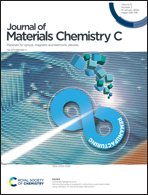A broadband self-powered photodetector based on NiPS3†
Abstract
Self-powered photodetectors have been attracting more and more attention due to the energy shortage issues around the world. As a type of layered van der Waals material, NiPS3 has garnered much attention in the realms of optoelectronics. In order to excavate the possible self-powered potential of this material, we utilized the asymmetric electrode contact design in the device structure of a NiPS3-based photodetector. Photoelectric characterization of the device presented a broadband spectral detection range from 254 nm to 1020 nm. The device showed a zero-bias photoelectric response with responsivity and detectivity of 2.3 mA W−1 and 6.2 × 109 Jones, respectively. Moreover, this photodetector exhibited a response time of less than 40 ms for both rising and decay times and low dark current (∼pA). The self-powered phenomenon is possibly attributed to the unbalanced Schottky barriers of the two electrode contacts. This study provides a potential route for van der Waals material-based photoelectric devices applied in wearable photoelectronic devices and green energy economy.



 Please wait while we load your content...
Please wait while we load your content...